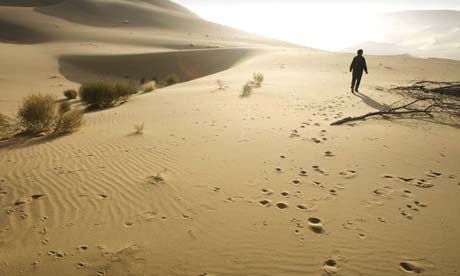Greetings to you, people of the year 2001! You are living in the year of my birth; I am one hundred years old now, writing to you from the year 2101. I am using the last remnants of the advanced physics that scientists developed during your era, in order to send this electronic message back in time to one of your computer networks. I hope that you receive it, and that it will give you reason to pause and reflect on your world and what actions to take with regard to it.

Of myself I shall say only what it is necessary to say: I am a survivor. I have been extremely fortunate on many occasions and in many ways, and I regard it as something of a miracle that I am here to compose this message. I have spent much of my life attempting to pursue the career of historian, but circumstances have compelled me also to learn and practice the skills of farmer, forager, guerrilla fighter, engineer – and now physicist. My life has been long and eventful . . . but that is not what I have gone to so much trouble to convey to you. It is what I have witnessed during this past century that I feel compelled to tell you by these extraordinary means.
You are living at the end of an era. Perhaps you cannot understand that. I hope that, by the time you have finished reading this letter, you will.
I want to tell you what is important for you to know, but you may find some of this information hard to absorb. Please have patience with me. I am an old man and I don’t have much time for niceties. If what I say seems unbelievable, think of it as science fiction. But please pay attention. The communication device I am using is quite unstable and there’s no telling how much of my story will actually get through to you. Please pass it along to others. It will probably be the only such message you will ever receive.
Since I don’t know how much information I will actually be able to convey, I’ll start with the most important items, ones that will be of greatest help in your understanding of where your world is headed. Energy has been the central organizing – or should I say, disorganizing? – principle of this century. Actually, in historical retrospect, I would have to say that energy was the central organizing principle of the nineteenth and twentieth centuries as well. People discovered new energy sources – coal, then petroleum – in the nineteenth century, and then invented all sorts of new technologies to make use of this freshly released energy. Transportation, manufacturing, agriculture, lighting, heating – all were revolutionized, and the results reached deep into the lives of everyone in the industrialized world. Everybody became utterly dependent on the new gadgets; on imported, chemically fertilized food; on chemically synthesized and fossil-fuel-delivered therapeutic drugs; on the very idea of perpetual growth (after all, it would always be possible to produce more energy to fuel more transportation and manufacturing – wouldn’t it?). Well, if the nineteenth and twentieth centuries were the upside of the growth curve, this past century has been the downside – the cliff. It should have been perfectly obvious to everyone that the energy sources on which they were coming to rely were exhaustible. Somehow the thought never sank in very deep. I suppose that’s because people generally tend to get used to a certain way of life, and from then on they don’t think about it very much. That’s true today, too. The young people now have never known anything different; they take for granted our way of life – scavenging among the remains of industrial civilization for whatever can be put to immediate use – as though this is how people have always lived, as if this is how we were meant to live. That’s why I’ve always been attracted to history, so that I could get some perspective on human societies as they change through time. But I’m digressing. Where was I?
Yes – the energy crisis. Well, it all started around the time I was born. Folks then thought it would be brief, that it was just a political or technical problem, that soon everything would get back to normal. They didn’t stop to think that “normal,” in the longer-term historical sense, meant living on the energy budget of incoming sunlight and of the vegetative growth of the biosphere. Perversely, they thought “normal” meant using fossil energy like there was no tomorrow. And, I guess, there almost wasn’t. That was a classic self-confirming expectation – nearly.
At first, most people thought the shortages could be solved with “technology.” However, in retrospect that’s quite ludicrous. After all, their modern gadgetry had been invented to use a temporary abundance of energy. It didn’t produce energy. Yes, there were the nuclear reactors (heavens, those things turned out to be nightmares!), but they cost so much energy to build and decommission that the power they produced during their lifetimes barely paid for them in energy terms. The same with photovoltaic panels: it seems that nobody ever sat down and calculated how much energy it actually took to manufacture them, starting with the silicon wafers produced as byproducts of the computer industry, and including the construction of the manufacturing plant itself. It turned out that the making of the panels ate up nearly as much power as the panels themselves generated duing their lifetime. Nevertheless, quite a few of them were built – I wish that more had been! – and many are still operating (that’s what’s powering the device that allows me to transmit this signal to you from the future). Solar power was a good idea; its main drawback was simply that it was incapable of satisfying people’s energy-guzzling habits. With the exhaustion of fossil fuels, no technology could have maintained the way of life that people had gotten used to. But it took quite a while for many to realize that. Their pathetic faith in technology turned out to be almost religious in character, as though their gadgets were votive objects connecting them with an invisible but omnipotent god capable of overturning the laws of thermodynamics.
Naturally, some of the first effects of the energy shortages showed up as economic recessions, followed by an endless depression. The economists had been operating on the basis of their own religion – an absolute, unshakable faith in the Market-as-God; in supply-and-demand. They figured that if oil started to run out, the price would rise, offering incentives for research into alternatives. But the economists never bothered to think this through. If they had, they would have realized that the revamping of society’s entire energy infrastructure would take decades, while the price signal from resource shortages might come only weeks or months before some hypothetical replacement would be needed. Moreover, they should have realized that there was no substitute for basic energy resources.
The economists could think only in terms of money; basic necessities like water and energy only showed up in their calculations in terms of dollar cost, which made them functionally interchangeable with everything else that was priceable – oranges, airliners, diamonds, baseball cards, whatever. But, in the last analysis, basic resources weren’t interchangeable with other economic goods at all: you couldn’t drink baseball cards, no matter how big or valuable your collection, once the water ran out. Nor could you eat dollars, if nobody had food to sell. And so, after a certain point, people started to lose faith in their money. And as they did so, they realized that faith had been the only thing that made money worth anything in the first place. Currencies just collapsed – first in one country, then in another. There was inflation, deflation, barter, and thievery on every imaginable scale as matters sorted themselves out.
In the era when I was born, commentators used to liken the global economy to a casino. A few folks were making trillions of dollars, euros, and yen trading in currencies, companies, and commodity futures. None of these people were actually doing anything useful; they were just laying down their bets and, in many cases, raking in colossal winnings. If you followed the economic chain, you’d see that all of that money was coming out of ordinary people’s pockets . . . but that’s another story. Anyway: all of that economic activity depended on energy, on global transportation and communication, and on faith in the currencies. Early in the twenty-first century, the global casino went bankrupt. Gradually, a new metaphor became operational. We went from global casino to village flea market.
More




 A number of internal documents were apparently leaked this week from conservative think tank,
A number of internal documents were apparently leaked this week from conservative think tank, 




